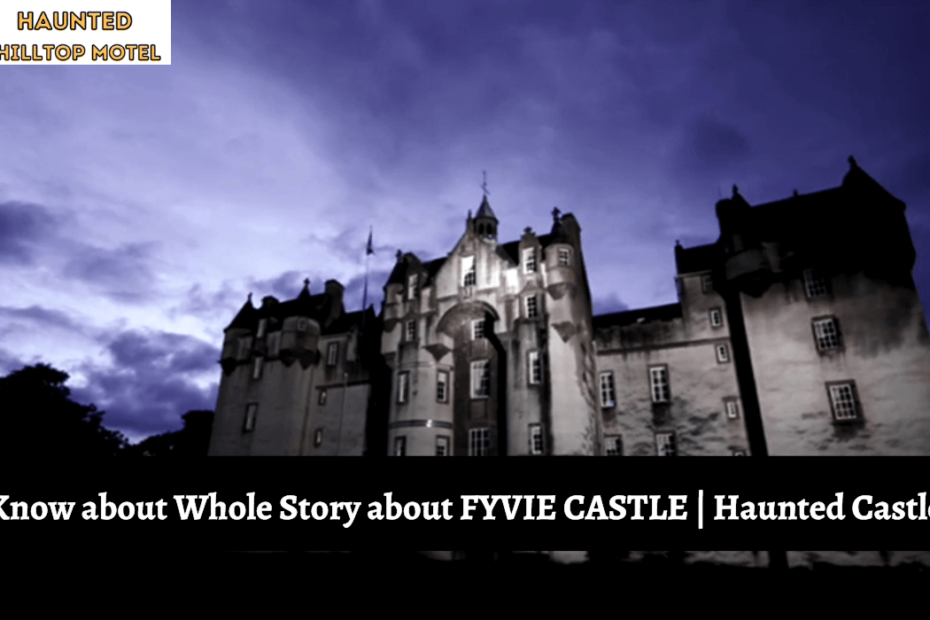Know about Whole Story about FYVIE CASTLE | Haunted Castle: As with most ancient castles, Fyvie Castle is no exception, and there are even a few more ghost stories to add to the mix. Here are just a few of the ghosts and tales associated with this historic castle, which is regarded by many as one of Scotland’s most haunted locations.
Sprite of Grey Lady : Believed to be the spirit of Lady Meldrum, who passed away in the thirteenth century. She may have asked to be interred within the walls of a hidden chamber in the Meldrum Tower.
Her remains weren’t discovered until 1920. After the remains were interred in the cemetery, the castle started to experience a number of weird and unexplainable phenomena. Lady Meldrum has appeared numerous times; as a result, many people claim that she is the castle’s “head ghost.”
Phantom Trumpeter: The ghost of Andrew Lammie, who committed suicide due to a shattered heart after learning of Agnes’s passing, is thought to be playing a trumpet throughout the castle.
Near the castle wall, Andrew is also reported to show up clothed in luxurious tartan. The figure of a guy has been spotted on multiple occasions, but when approached, he always vanishes.
The Legend of ‘The Weeping Stones of Fyvie’
Thomas the Rhymer, often known as True Thomas (because of his propensity for foretelling the future), mentioned a prophecy when he visited the castle some time ago.
You’ll never prosper, Fyvie,
Three stones are present in the three as of now.
Even in the oldest tower, there is one.
There is one in the lady’s flowerbed.
Up until the water-yett (watergate), there is one.
And you never receive those three stanes.
The three stones mentioned in this letter were used to build the Preston Tower, the Charter Room, and one stone that was thrown into the Ythan River. No male heir will ever be able to inherit the castle because they were stolen from a revered burial location until they are brought back.
The stones are also claimed to stay wet when everything else is dry and dry when everything else is wet. One of the stones, which was discovered in the Charter room, is still visible on the castle. Is the tale accurate? Nobody is sure, although it’s possible that there is some truth to the rumour given that a male heir has never lived long enough to inherit Fyvie Castle.
Green Lady: Believed to be Dame Lilias Drummond, Sir Alexander Seton’s spouse. Alexander became impatient after giving birth to five female children and no male ones.
His focus shifted to Grizel Leslie, his wife’s cousin, as he yearned for a son. Lillias retired to their house in Fife, where she fell ill and passed away soon after, feeling betrayed and heartbroken.
According to legend, Alexander and Grizel castle bedroom neighbours on the night of their marriage heard what they thought to be the wind but turned out to be loud sighs coming from outside their window.
Alexander discovered the inscription D LILIAS DRUMMOND carved into the stone as he opened the window in the morning. Even today, people still use this name!
HISTORY Of FYVIE CASTLE :
Fyvie Castle near Turriff in Aberdeenshire, Scotland, is believed to have been built around the 13th Century by William the Lion. The castle served as a Royal stronghold until 1390, shortly after the Battle of Otterburn. After Royal ownership, it was passed down to a succession of clan families. Scottish families of Preston, Meldrum, Seton, Gordon, and Leith, respectively.
Each of the families constructed a new tower onto the castle, the first being the Preston Tower. Dated between 1390-1433, the tower remains to this day.
The Seton family added the Seton Towers in 1599, which you can see dominating the entrance to the castle. The great processional staircase was also added by Seton’s sometime after. The Gordon Tower was added in 1777, and lastly, the Leith Tower in 1890. There are several famous pictures and displays of real armour and weapons in the castle.
Alexander Leith, who owned the castle from the late 1800s to the early 1900s, and his heirs sold it to the National Trust for Scotland in 1984. Visitors can currently tour the castle and learn about its architecture, art collection, and family history.
| Homepage | Click Here |
| Haunted House Category | Click Here |
